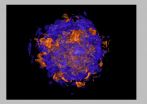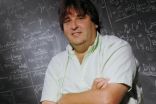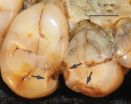(Press-News.org) For scientists, supernovae are true superstars -- massive explosions of huge, dying stars that shine light on the shape and fate of the universe.
For a brief burst of time, supernovae can radiate more energy than the sun will emit in its lifetime. With the potential energy of 25 hundred trillion trillion nuclear weapons, they can outshine entire galaxies, producing some of the biggest explosions ever seen, and helping track distances across the cosmos.
Now, a Princeton-led team has found a way to make computer simulations of supernovae exploding in three dimensions, which may lead to new scientific insights.
Even though these mammoth explosions have been observed for thousands of years, for the past 50 years researchers have struggled to mimic the step-by-step destructive action on computers. Researchers argue that such simulations, even crude ones, are important, as they can lead to new information about the universe and help address this longstanding problem in astrophysics.
The new 3-D simulations are based on the idea that the collapsing star itself is not sphere-like, but distinctly asymmetrical and affected by a host of instabilities in the volatile mix surrounding its core.
"I think this is a big jump in our understanding of how these things can explode," said Adam Burrows, a professor of astrophysical sciences at Princeton, who led the research. "In principle, if you could go inside the supernovae to their centers, this is what you might see."
Writing in the Sept. 1 issue of the Astrophysical Journal, Burrows -- along with first author Jason Nordhaus, a postdoctoral research fellow at Princeton, and Ann Almgren and John Bell from the Lawrence Berkeley National Laboratory in California -- reports that the Princeton team has developed simulations that are beginning to match the massive blow-outs astronomers have witnessed when gigantic stars die.
In the past, simulated explosions represented in one and two dimensions often stalled, leading scientists to conclude that their understanding of the physics was incorrect or incomplete. This team used the same guiding physics principles, but used supercomputers that were many times more powerful, employing a representation in three dimensions that allowed the various multidimensional instabilities to be expressed.
"It may well prove to be the case that the fundamental impediment to progress in supernova theory over the last few decades has not been lack of physical detail, but lack of access to codes and computers with which to properly simulate the collapse phenomenon in 3-D," the team wrote. "This could explain the agonizingly slow march since the 1960s toward demonstrating a robust mechanism of explosion."
Birth of a supernova
Supernovae are the primary source of heavy elements in the cosmos. Their brightness is so consistently intense that supernovae have been used as "standard candles" or gauges, acting as yardsticks indicating astronomical distances.
Most result from the death of single stars much more massive than the sun.
As a star ages, it exhausts its supplies of hydrogen and helium fuel at its core. With still enough mass and pressure to fuse carbon and produce other heavier elements, it gradually becomes layered like an onion with the bulkiest tiers at its center. Once its core exceeds a certain mass, it begins to implode. In the squeeze, the core heats up and grows even more dense.
"Imagine taking something as massive as the sun, then compacting it to something the size of the Earth," Burrows said. "Then imagine that collapsing to something the size of Princeton."
What comes next is even more mysterious.
At some point, the implosion reverses. Astrophysicists call it "the bounce." The core material stiffens up, acting like what Burrows calls a "spherical piston," emitting a shock wave of energy. Neutrinos, which are inert particles, are emitted too. The shock wave and the neutrinos are invisible.
Then, very visibly, there is a massive explosion, and the star's outer layers are ejected into space. This highly perceptible stage is what observers see as the supernova. What's left behind is an ultra-dense object called a neutron star. Sometimes, when an ultramassive star dies, a black hole is created instead.
Scientists have a sense of the steps leading to the explosion, but there is no agreed upon fundamental process about what happens during the "bounce" phase when the implosion at the core reverses direction. Part of the difficulty is that no one can see what is happening on the inside of a star. During this phase, the star looks undisturbed. Then, suddenly, a blast wave erupts on the surface. Scientists don't know what occurs to make the central region of the star instantly unstable. The emission of neutrinos is believed to be related, but no one is sure how or why.
"We don't know what the mechanism of explosion is," Burrows said. "As a theorist who wants to get to root causes, this is a natural problem to explore."
Multiple scientific approaches to solve the problem
The scientific visualization employed by the research team is an interdisciplinary effort combining astrophysics, applied mathematics and computer science. The endeavor produces a presentation through computer-generated images of three-dimensional phenomena. In general, researchers employ visualization techniques with the aim of making realistic renderings of quantitative information including surfaces, volumes and light sources. Time is often an important component, contributing to making the images dynamical as well.
To do their work, Burrows and his colleagues came up with mathematical values representing the energetic behaviors of stars by using mathematical representations of fluids in motion -- the same partial differential equations solved by geophysicists for climate modeling and weather forecasting. To solve these complex equations and simulate what happens inside a dying star, the team used an advanced computer code called CASTRO that took into account factors that changed over time, including fluid density, temperature, pressure, gravitational acceleration and velocity.
The calculations took months to process on supercomputers at Princeton and the Lawrence Berkeley Laboratory.
The simulations are not an end unto themselves, Burrows noted. Part of the learning process is viewing the simulations and connecting them to real observations. In this case, the most recent simulations are uncannily similar to the explosive behavior of stars in their death throes witnessed by scientists. In addition, scientists often learn from simulations and see behaviors they had not expected.
"Visualization is crucial," Burrows said. "Otherwise, all you have is merely a jumble of numbers. Visualization via stills and movies conjures the entire phenomenon and brings home what has happened. It also allows one to diagnose the dynamics, so that the event is not only visualized, but understood."
INFORMATION:
The research was funded by the U.S. Department of Energy and the National Science Foundation.
3-D computer simulations help envision supernovae explosions
2010-09-16
ELSE PRESS RELEASES FROM THIS DATE:
Asthma and cavities both common in kids but not linked
2010-09-16
INDIANAPOLIS – There is no apparent link between asthma and tooth decay, according to a study published in the September 2010 issue of the Journal of the American Dental Association.
"Is There a Relationship between Asthma and Dental Caries?: A Critical Review of the Literature" examined the 27 separate studies which looked for a link between asthma and cavities that were reported in 29 papers published between 1976 and March 2010.
"The notion that there is a link between asthma and tooth decay may have its origin in anecdotal statements by emergency room workers who ...
Disease transmission model says media coverage cuts infection rate and pandemic extent
2010-09-16
At the first sign of a disease pandemic, public health officials should begin strongly communicating about the extent of the outbreak and the steps that can be taken by the public to avoid infection. That's the recommendation of two mathematical biologists who have modified the most widely used infectious disease transmission model to account for the impact of news media coverage.
During outbreaks of serious infectious diseases, many individuals closely follow media reports and as a result, take precautions to protect themselves against the disease. These precautions ...
October 2010 Lithosphere highlights
2010-09-16
Boulder, CO, USA – The October LITHOSPHERE examines the following key questions: (1) how do large volumes of silicic magma contribute to the growth of continental crust?; (2) how does the Tibetan Plateau grow?; (3) what are the dynamics of the lithosphere beneath the Eastern Carpathians in Romania?; (4) what's really true about the Mojave-Snow Lake fault hypothesis?; (5) can Earth's pulse be measured at its hotspots?; and (6) what is the nature of the Moho in NW Canada?
Keywords: Philipsburg Batholith, Tibetan Plateau, Carpathians, Mojave-Snow Lake fault, hotspots, Moho.
Highlights ...
A chip off the early hominin tooth
2010-09-16
Were our early mammalian ancestors vegetarians, vegans or omnivores? It's difficult for anthropologists to determine the diet of early mammalians because current fossil analysis provides too little information. But a new method that measures the size of chips in tooth fossils can help determine the kinds of foods these early humans consumed.
Prof. Herzl Chai of Tel Aviv University's School of Mechanical Engineering, in collaboration with scientists from George Washington University and the U.S. National Institute of Standards and Technology (NIST), has developed an equation ...
Undergraduate research highlighted in DNA and Cell Biology Journal
2010-09-16
New Rochelle, NY, September 16, 2010—Not only do undergraduate students gain valuable hands-on experience by participating in scientific research projects, but they also make meaningful contributions, examples of which are highlighted in the current special issue of DNA and Cell Biology, a peer-reviewed journal published by Mary Ann Liebert, Inc. The issue is available free online.
This special issue features a collection of papers reporting on successful research projects in which undergraduate students played a significant role, "and undoubtedly learned much in the ...
Bacteria identified that may lead to inflammatory bowel disease in certain individuals
2010-09-16
Certain bacteria that inhabit the intestine provide the environmental trigger that initiates and perpetuates chronic intestinal inflammation in individuals who are genetically susceptible to inflammatory bowel disease (IBD), a study led by Harvard School of Public Health researchers has found.
Inflammatory bowel disease results from a loss of homeostasis, or balance, between the immune system and the microbes that inhabit the intestine. "In this study, we identified two microbes that instigate gut inflammation that leads to inflammatory bowel disease in mice," said ...
UCSB, Texas A&M scientists document fate of deep hydrocarbon plumes in Gulf oil spill
2010-09-16
SANTA BARBARA, Calif., Sept. 16, 2010 — In the aftermath of the Deepwater Horizon disaster in the Gulf of Mexico, a team of scientists led by UC Santa Barbara's David Valentine and Texas A&M University's John Kessler embarked on a research cruise with an urgent mission: determining the fate and impact of hydrocarbon gases escaping from a deep-water oil spill.
The spill provided a rare opportunity for Valentine, a professor in the Department of Earth Science at UCSB, and Kessler, an assistant professor in the Department of Oceanography at Texas A&M, to study the behavior ...
Scripps scientists develop test providing new pathway for identifying obesity, diabetes drugs
2010-09-16
La Jolla, CA, September 15, 2010 – Scientists at The Scripps Research Institute have designed a new molecular test that will allow researchers to look for potential drugs targeting a human metabolic enzyme believed to stimulate the appetite and play a role in diabetes.
The new test, which the scientists call a simple assay, will allow researchers to look through hundreds of thousands of compounds for those that have potential to block the action of an enzyme known as ghrelin O-acyltransferase (GOAT). If drugs can be found that safely suppress the action of GOAT, they ...
Fat stem cells safe for breast reconstruction when cancer is dormant, says Pitt team
2010-09-16
PITTSBURGH, Sept. 15 – Fat-derived stem cells can be safely used to aid reconstruction of breast tissue after mastectomy as long as there is no evidence of active cancer, according to researchers at the University of Pittsburgh School of Medicine. Their findings are available in Tissue Engineering Part A.
Plastic surgeons have long moved fat from one part of the body into the breasts for reconstruction, but with some complications and a varying success rate, explained senior author Vera S. Donnenberg, Ph.D., assistant professor of surgery, Pitt School of Medicine. More ...
Significant weight-loss from surgery decreases risk for cardiovascular disease in women
2010-09-16
Significant weight loss not only improves daily life of morbidly obese woman but also decreases the risk for cardiovascular disease (CVD). However, many people can not lose weight or can not maintain weight loss without help. Bariatric surgery is emerging as a valuable procedure to help morbidly obese individuals lose weight, as studies have shown; it can improve many health profiles and lower mortality. Now, researchers have found another positive impact of significant weight loss after bariatric surgery: it can significantly improve the lipoprotein profiles of women within ...



